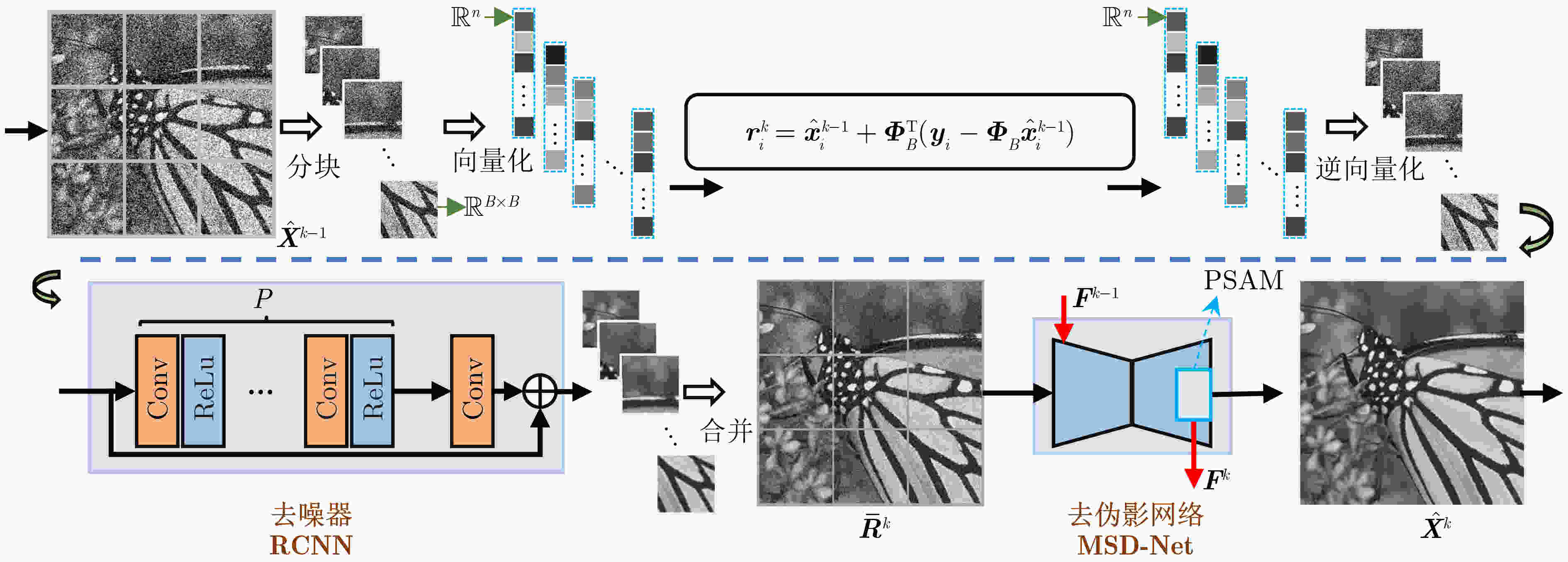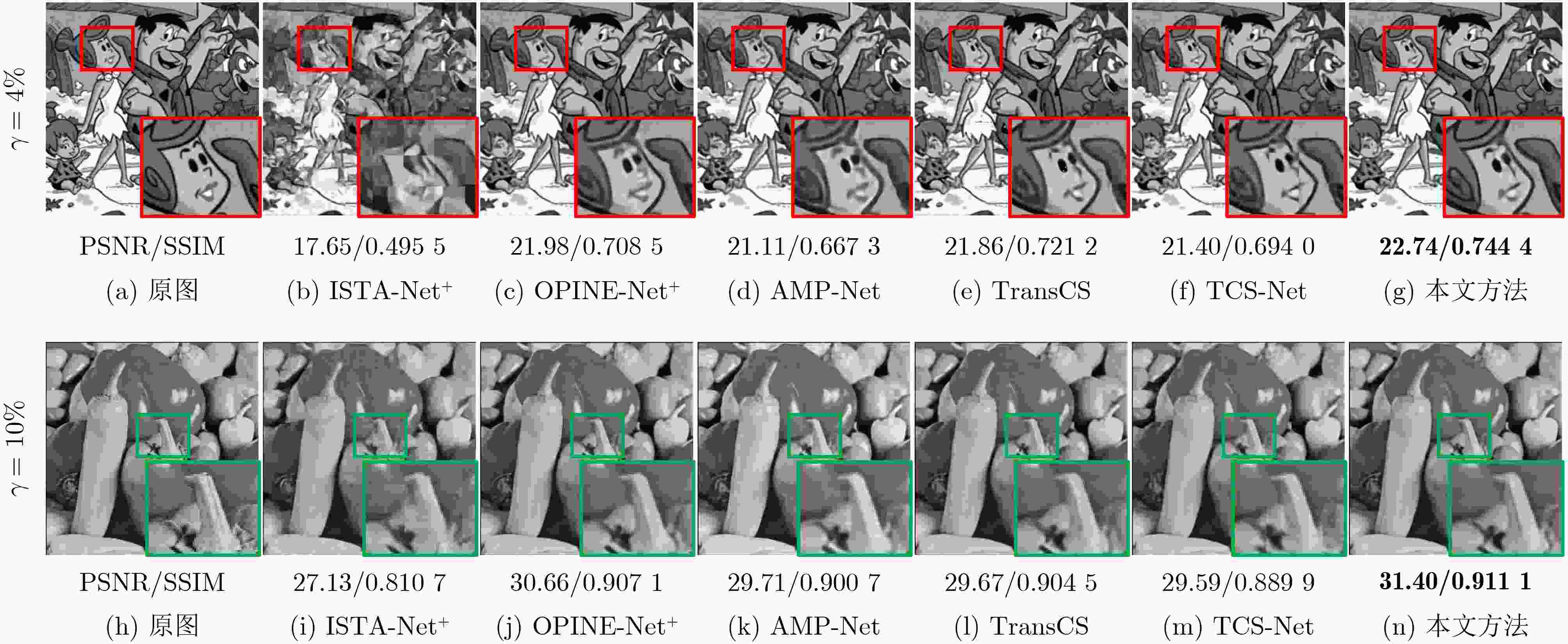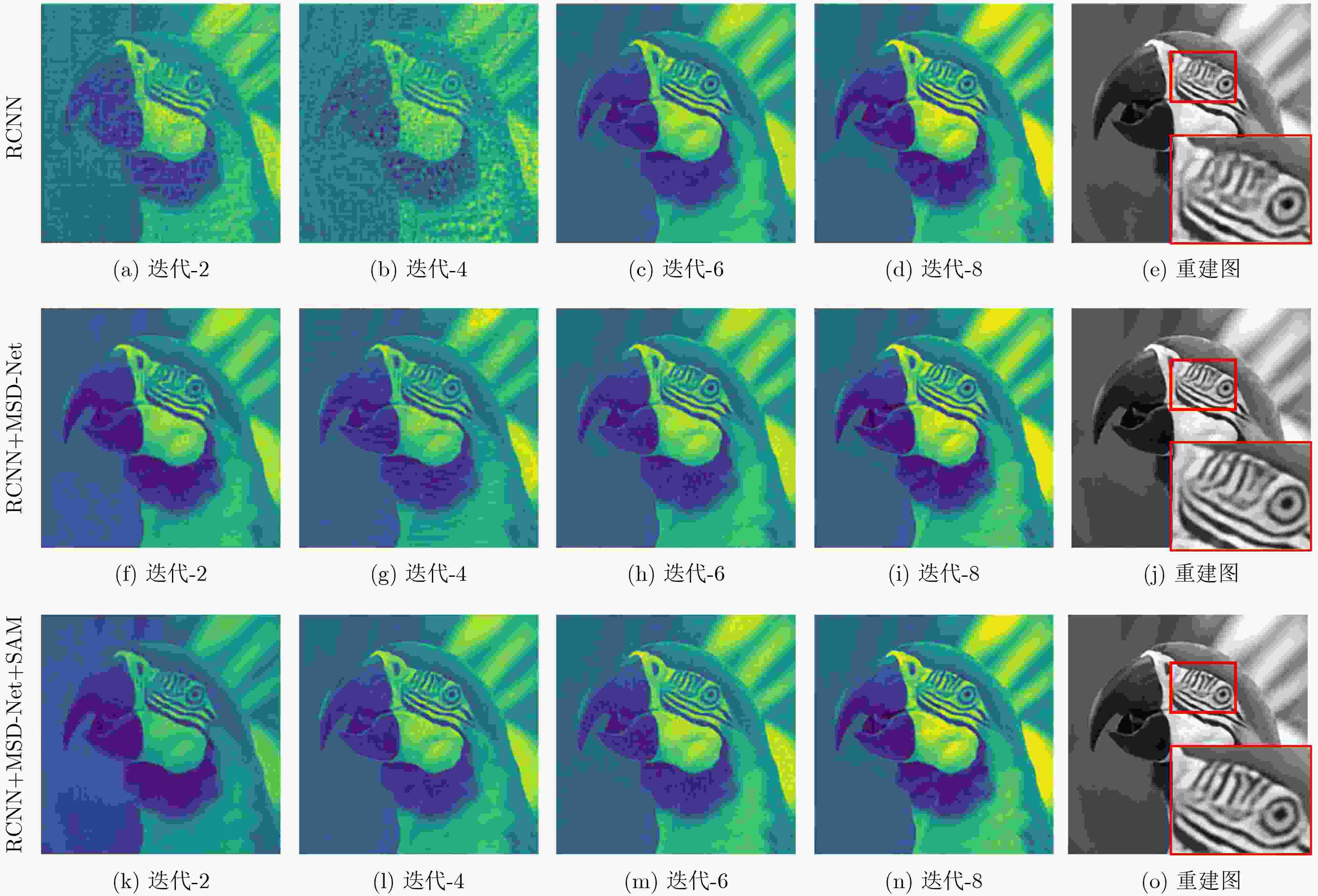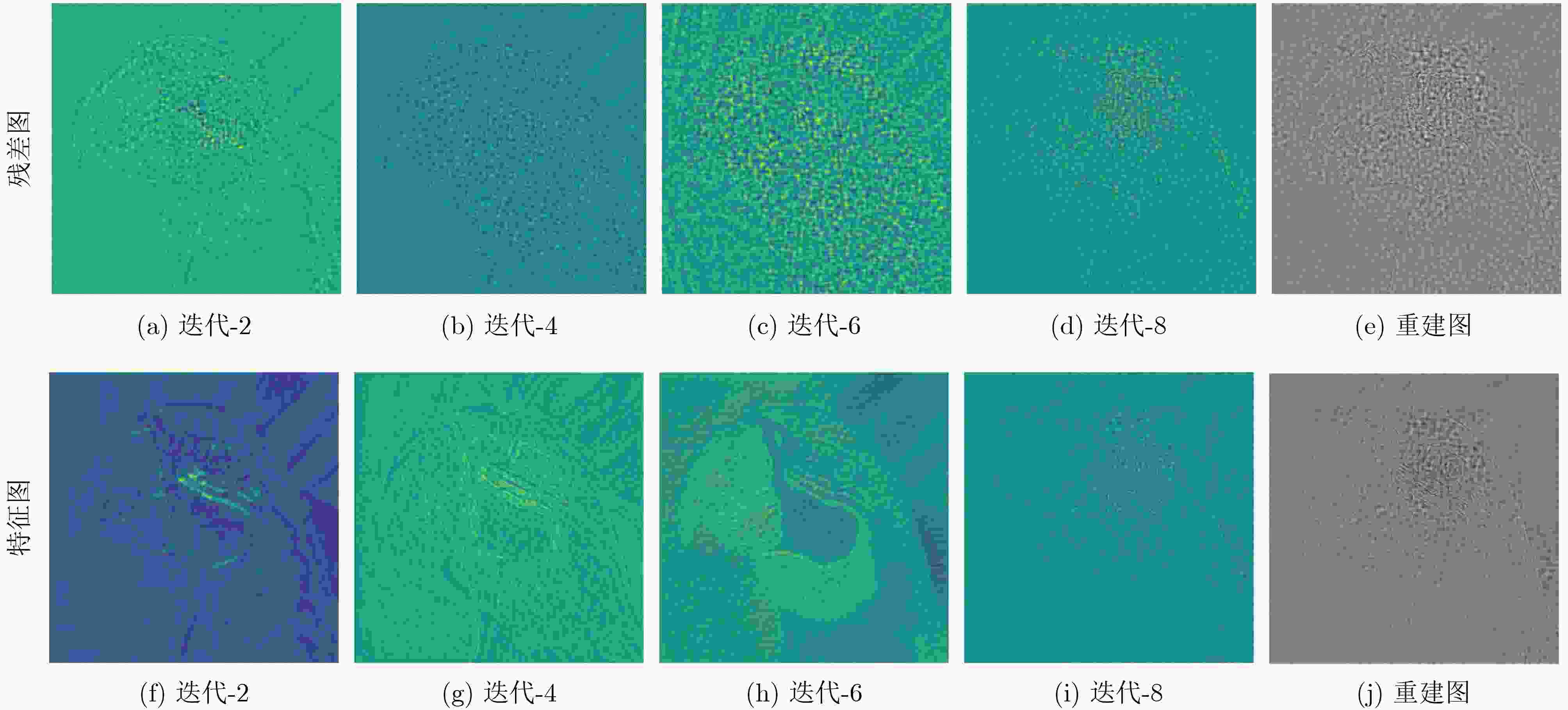Pseudo Supervised Attention Short-term Memory and Multi-Scale Deartifacting Network Based on Image Block Compressed Sensing
-
摘要: 基于深度展开网络的分块压缩感知(BCS)方法,在迭代去块伪影时通常会同时去除部分信号和保留部分块伪影,不利于信号恢复。为了改善重建性能,在学习去噪的迭代阈值(LDIT) 算法基础上,该文提出基于伪监督注意力短期记忆与多尺度去伪影网络(MSD-Net)的图像BCS迭代方法(PSASM-MD)。首先,在每步迭代中,利用残差网络并行地对每个图像子块单独去噪后再拼接。然后,对拼接后的图像采用含有伪监督注意力模块(PSAM)的MSD-Net进行特征提取,以更好地去除块伪影以提高重建性能。其中,PSAM被用于从含有块伪影的残差中抽取部分有用信号,并传递到下一步迭代实现短期记忆,以尽量避免去除有用信号。实验结果表明,该文方法相比现有先进的同类BCS方法在主观视觉感知和客观评价指标上均取得了更优的结果。Abstract: Deep unfolding network based Block Compressed Sensing (BCS) methods typically remove some signal and retain certain block artifacts simultaneously during iterative deartifacting, which is unfavorable for signal recovery. To enhance reconstruction performance, based on Learned Denoising Iterative Thresholding (LDIT) algorithm. Pseudo Supervised Attention Short-term Memory and Multi-scale Deartifacting (PSASM-MD) based image BCS, is proposed in this paper. Initially, in each iteration, each image block is denoised separately in parallel using residual networks before being concatenated. Subsequently, in conjunction with the Pseudo-Supervised Attention Module (PSAM), Multi-Scale Deartifacting Network (MSD-Net) is used to perform feature extraction on the concatenated images, enabling more efficient removal of block artifacts and improving the reconstruction performance. In this case, PSAM is utilized to extract useful signal components from the residuals containing block artifacts, transfer the short-term memory to the subsequent iteration to minimize the removal of useful signals. Experimental results demonstrate that this approach outperforms existing state-of-the-art BCS methods both in subjective visual perception and objective evaluation metrics.
-
表 1 几种BCS算法在Set11上不同采样率下PSNR(dB)/SSIM的平均值
采样率$\gamma $(%) ISTA-Net+ OPINE-Net+ AMP-Net TransCS TCS-Net PSASM-MD 1 17.45/0.4131 20.15/0.5340 20.20/0.5580 -/- 21.09/0.5505 22.01/0.6077 4 21.56/0.6240 25.69/0.7920 25.26/0.7722 25.41/0.7883 25.46/0.7863 26.40/0.8001 10 26.49/0.8036 29.81/0.8884 29.40/0.8779 29.54/0.8877 29.04/0.8834 30.40/0.8906 25 32.44/0.9237 34.86/0.9509 34.63/0.9481 35.06/0.9548 33.94/0.9508 35.24/0.9519 50 38.07/0.9706 40.17/0.9797 40.34/0.9804 40.49/0.9815 -/- 40.90/0.9812 表 2 几种BCS算法在BSD68 上不同采样率下PSNR(dB)/SSIM的平均值
采样率$\gamma $(%) ISTA-Net+ OPINE-Net+ AMP-Net TransCS TCS-Net PSASM-MD 1 19.18/0.4201 22.11/0.5140 21.97/0.5086 -/- 22.26/0.5194 22.89/0.5530 4 22.34/0.5573 25.00/0.6825 25.40/0.6985 25.28/0.6881 25.07/0.6829 25.59/0.6847 10 25.30/0.7001 27.82/0.8045 27.41/0.8036 27.86/0.8086 27.42/0.8037 28.20/0.7993 25 29.31/0.8507 31.51/0.9061 31.56/0.9121 31.74/0.9121 30.94/0.9083 31.98/0.9069 50 34.01/0.9421 36.35/0.9660 36.64/0.9707 36.81/0.9699 -/- 37.19/0.9689 表 3 PSASM-MD不同网络结构下Set11上的平均PSNR(dB)/SSIM结果
采样率$\gamma $(%) RCNN RCNN+
DCNN[14]RCNN+
MSD-NetRCNN+MSD-Net+PSAM 4 25.49/
0.767626.06/0.7882 26.29/0.7962 26.40/0.7986 10 29.52/
0.877329.98/0.8848 30.11/0.8873 30.38/0.8914 -
[1] HOU Hao, SHAO Yuchen, GENG Yang, et al. PNCS: Pixel-level non-local method based compressed sensing undersampled MRI image reconstruction[J]. IEEE Access, 2023, 11: 42389–42402. doi: 10.1109/ACCESS.2023.3270900. [2] 王洋, 杨孟宇, 赵首博. 基于自适应分块的高光谱图像压缩感知重构方法[J]. 电子与信息学报, 2023, 45(7): 2605–2613. doi: 10.11999/JEIT220738.WANG Yang, YANG Mengyu, and ZHAO Shoubo. Compressed sensing reconstruction of hyperspectral images based on adaptive blocking[J]. Journal of Electronics & Information Technology, 2023, 45(7): 2605–2613. doi: 10.11999/JEIT220738. [3] LIU Yang, YUAN Xin, SUO Jinli, et al. Rank minimization for snapshot compressive imaging[J]. IEEE Transactions on Pattern Analysis and Machine Intelligence, 2019, 41(12): 2990–3006. doi: 10.1109/TPAMI.2018.2873587. [4] TROPP J A and GILBERT A C. Signal recovery from random measurements via orthogonal matching pursuit[J]. IEEE Transactions on Information Theory, 2007, 53(12): 4655–4666. doi: 10.1109/TIT.2007.909108. [5] BECK A and TEBOULLE M. A fast iterative shrinkage-thresholding algorithm for linear inverse problems[J]. SIAM Journal on Imaging Sciences, 2009, 2(1): 183–202. doi: 10.1137/080716542. [6] METZLER C A, MOUSAVI A, and BARANIUK R. Learned D-AMP: Principled neural network based compressive image recovery[C]. The 31st International Conference on Neural Information Processing Systems, Long Beach, USA, 2017: 1770–1781. doi: 10.5555/3294771.3294940. [7] MOUSAVI A, PATEL A B, and BARANIUK R G. A deep learning approach to structured signal recovery[C]. The 53rd Annual Allerton Conference on Communication, Control, and Computing, Monticello, USA, 2015: 1336–1343. doi: 10.1109/ALLERTON.2015.7447163. [8] KULKARNI K, LOHIT S, TURAGA P, et al. ReconNet: Non-iterative reconstruction of images from compressively sensed measurements[C]. IEEE Conference on Computer Vision and Pattern Recognition, Las Vegas, USA, 2016: 449–458. doi: 10.1109/CVPR.2016.55. [9] GAN Hongping, SHEN Minghe, HUA Yi, et al. From patch to pixel: A transformer-based hierarchical framework for compressive image sensing[J]. IEEE Transactions on Computational Imaging, 2023, 9: 133–146. doi: 10.1109/TCI.2023.3244396. [10] LIU Ze, LIN Yutong, GAO Yue, et al. Swin transformer: Hierarchical vision transformer using shifted windows[C]. IEEE International Conference on Computer Vision, Montreal, Canada, 2021: 9992–10002. doi: 10.1109/ICCV48922.2021.00986. [11] ZHANG Jian, CHEN Bin, XIONG Ruiqin, et al. Physics-inspired compressive sensing: Beyond deep unrolling[J]. IEEE Signal Processing Magazine, 2023, 40(1): 58–72. doi: 10.1109/MSP.2022.3208394. [12] ZHANG Jian and GHANEM B. ISTA-Net: Interpretable optimization-inspired deep network for image compressive sensing[C]. IEEE Conference on Computer Vision and Pattern Recognition, Salt Lake City, USA, 2018: 1828–1837. doi: 10.1109/CVPR.2018.00196. [13] ZHANG Jian, ZHAO Chen, and GAO Wen. Optimization-inspired compact deep compressive sensing[J]. IEEE Journal of Selected Topics in Signal Processing. 2020, 14(4): 765–774. doi: 10.1109/JSTSP.2020.2977507. [14] ZHANG Zhonghao, LIU Yipeng, LIU Jiani, et al. AMP-Net: Denoising-based deep unfolding for compressive image sensing[J]. IEEE Transactions on Image Processing, 2021, 30: 1487–1500. doi: 10.1109/TIP.2020.3044472. [15] CHEN Chang, XIONG Zhiwei, TIAN Xinmei, et al. Real-world image denoising with deep boosting[J]. IEEE Transactions on Pattern Analysis and Machine Intelligence, 2020, 42(12): 3071–3087. doi: 10.1109/TPAMI.2019.2921548. [16] MA Jiayi, PENG Chengli, TIAN Xin, et al. DBDnet: A deep boosting strategy for image denoising[J]. IEEE Transactions on Multimedia, 2022, 24: 3157–3168. doi: 10.1109/TMM.2021.3094058. [17] SHEN Minghe, GAN Hongping, NING Chao, et al. TransCS: A transformer-based hybrid architecture for image compressed sensing[J]. IEEE Transactions on Image Processing, 2022, 31: 6991–7005. doi: 10.1109/TIP.2022.3217365. [18] CUI Wenxue, LIU Shaohui, JIANG Feng, et al. Image compressed sensing using non-local neural network[J]. IEEE Transactions on Multimedia, 2023, 25: 816–830. doi: 10.1109/TMM.2021.3132489. [19] ZHANG Kai, ZUO Wangmeng, CHEN Yunjin, et al. Beyond a Gaussian denoiser: Residual learning of deep CNN for image denoising[J]. IEEE Transactions on Image Processing, 2017, 26(7): 3142–3155. doi: 10.1109/TIP.2017.2662206. [20] RONNEBERGER O, FISCHER P, and BROX T. U-Net: Convolutional networks for biomedical image segmentation[C]. 18th International Conference, Munich, Germany, 2015: 234–241. doi: 10.1007/978-3-319-24574-4_28. [21] WANG Huake, LI Ziang, and HOU Xingsong. Versatile denoising-based approximate message passing for compressive sensing[J]. IEEE Transactions on Image Processing, 2023, 32: 2761–2775. doi: 10.1109/TIP.2023.3274967. [22] LIU Pengju, ZHANG Hongzhi, ZHANG Kai, et al. Multi-level wavelet-CNN for image restoration[C]. Proceedings of the IEEE Conference on Computer Vision and Pattern Recognition Workshops, Salt Lake City, USA, 2018: 886. doi: 10.1109/CVPRW.2018.00121. [23] MARTIN D, FOWLKES C, TAL D, et al. A database of human segmented natural images and its application to evaluating segmentation algorithms and measuring ecological statistics[C]. 8th IEEE International Conference on Computer Vision, Vancouver, Canada, 2001: 416–423. doi: 10.1109/ICCV.2001.937655. [24] WANG Zhou, BOVIK A C, SHEIKH H R, et al. Image quality assessment: From error visibility to structural similarity[J]. IEEE Transactions on Image Processing, 2004, 13(4): 600–612. doi: 10.1109/TIP.2003.819861. [25] LOSHCHILOV I and HUTTER F. Decoupled weight decay regularization[C]. 7th International Conference on Learning Representations, New Orleans, USA, 2019. -






 下载:
下载:









 下载:
下载:
